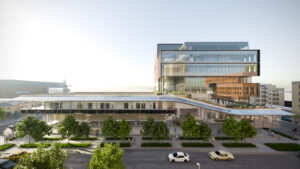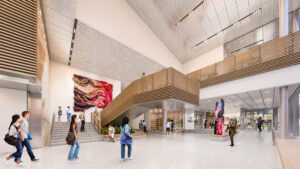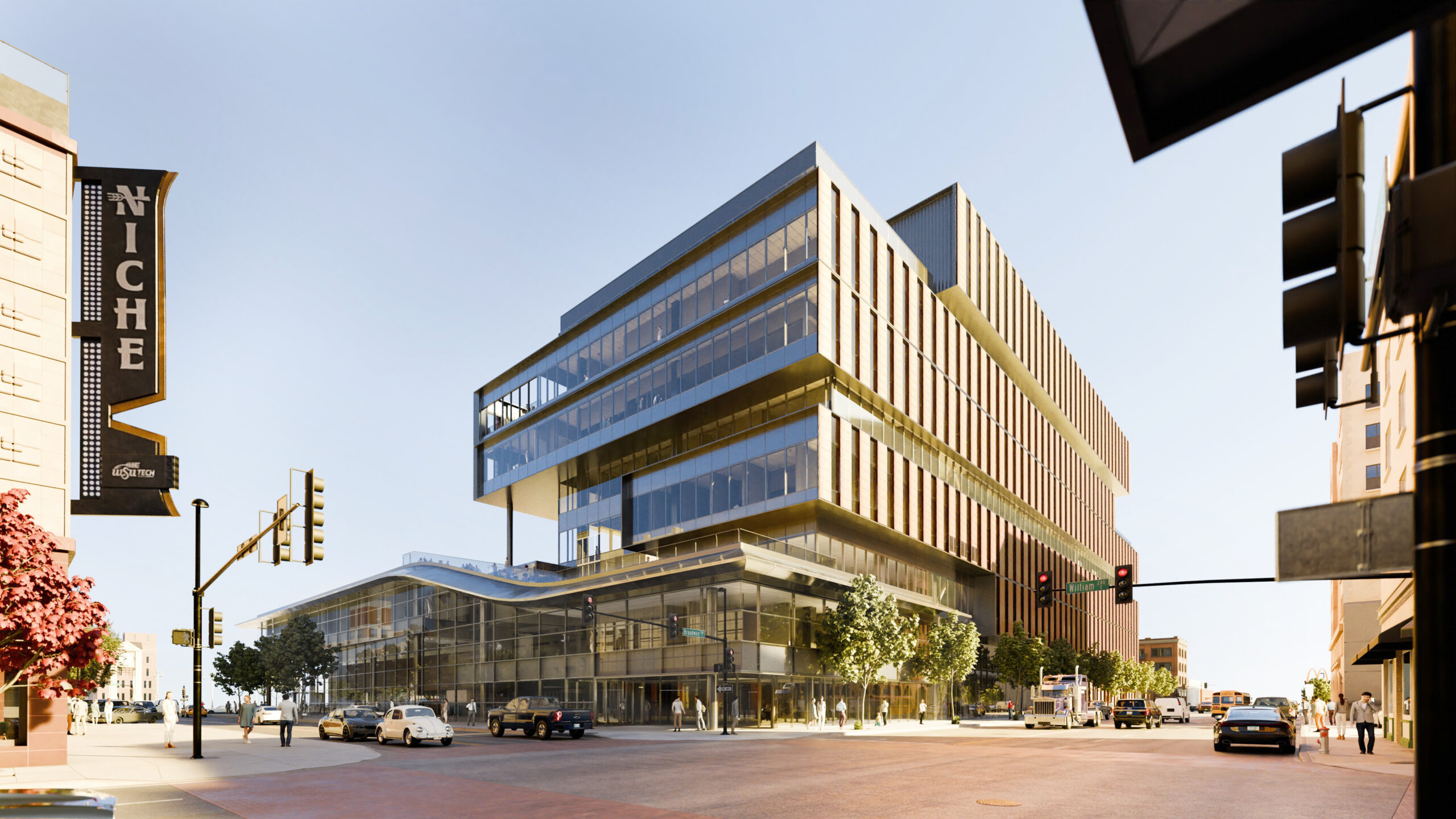Photo: The under-construction Wichita Biomedical Campus will house health-sciences programs from three institutions: Wichita State University, University of Kansas Medical Center, and WSU Tech.
By Clay Phillips, AIA
Higher education buildings often have more stakeholders than other projects. Architects are tasked with integrating input from deans, department heads, faculty, facilities staff, and even students and donors. Lab-intensive health sciences facilities further intensify client coordination—universities are looking for 50-, 75-, even 100-year buildings, and the constantly evolving simulation technology for health sciences education requires us to consider current needs and future possibilities. The benefit of working for universities is that they understand the investment it takes to create enduring, complex projects with high-quality design.

A prime example is a project that is currently under construction and one of the most complex of my 30-year career. The Wichita Biomedical Campus is a collaboration among two design firms—Helix Architecture + Design and CO Architects—and three schools: Wichita State University (WSU), WSU Tech, and University of Kansas Medical Center (KUMC). The 350,000-square-foot, eight-story building will consolidate multiple interdisciplinary programs. WSU’s College of Health Professions and Speech-Language-Hearing Clinic, WSU Tech’s Health Professions program, and the Wichita campuses of KU School of Medicine and KU School of Pharmacy will collocate at the new campus. Future doctors, nurses, physical therapists, pharmacists, and medical technicians will learn alongside each other, foreshadowing real-world working conditions.
The COVID-19 pandemic propelled the collaboration between the three institutions after the schools initially investigated separate buildings. Increased local need for health sciences education paired with decreasing resources spawned “better together” conversations, leading to creation of a regionally significant shared campus in downtown Wichita.
Helix and CO were hired jointly to design Phase I of the WBC. The two firms have collaborated on several medical education buildings during the past decade and enjoy a productive working relationship. Creative alignment included a charette with team members from both firms to discuss big-picture ideas. Based on an enduring rapport and collaborative design rhythm, the combined team decided that CO would leverage its expertise in medical simulation spaces and lead the building’s overall design. Helix would lend its proficiency in university buildings and workplaces to oversee the interiors and add context-based local design insights throughout.
Apportioning Resources
Coordinating a project among three distinct clients with a two-firm design team required extensive front-end planning. The three schools formed a project steering committee of roughly a dozen representatives. Our design team hosted multiple sessions with the steering committee, both in person and virtually. Break-out sessions with more than 15 departments were also held, some with more than 30 people sharing opinions. Having a set end date helped keep the project on track, and we were able to release the project in multiple bid packages to accelerate the design schedule.
Each academic institution brought its own priorities to the table and wanted its respective school culture adequately represented. Early in the process, we presented multiple stacking diagrams to illustrate options and guide decision-making. The design consensus evolved from our initial approach of integrating the three users throughout to each having separate areas in addition to some common spaces.
Shared learning environments required compromise as well. The simulation and anatomy labs became the focal points of early planning discussions. These interdisciplinary learning spaces will feature advanced labs and cutting-edge simulation rooms for immersive, hands-on training—expensive learning tools that helped drive the institutions’ decision to do the joint venture.
Interior Palettes, Exterior Influences

Photo Credit (all): Courtesy CO Architects
Beyond school-specific spaces, the interior is designed as a collaborative, cross-disciplinary hub for all students. Thus, we wanted the interior palette to not favor one institution or another. KUMC and the WSU schools use bold, high-contrast school colors: red/blue and black/yellow, respectively. To unify shared spaces, our interiors team selected more restrained tones that subtly reference these palettes. Labs and conference rooms feature warm, modern hues, while brighter, more energetic colors appear in classrooms, student lounges and learning hubs. Staff lounges and offices incorporate vibrant accents for contrast.
Wayfinding strategies were key considerations in interior design. In addition to helping students and staff navigate the building, clear signage also supports the WBC’s public-facing functions, including a new third-floor clinic that will expand high-demand health services in Wichita.
For the WBC’s façade, the Helix/CO team drew inspiration from the nearby Flint Hills and their distinctive stair-step geology, juxtaposing terra-cotta panels and bands of glass on a stepped profile. Transforming Wichita’s skyline, a street-facing, three-story pavilion houses three 80-seat classrooms that can easily convert into an events venue, with an attached rooftop terrace overlooking a major city thoroughfare. To reinforce local connections, key community areas within the building were intentionally positioned to frame views of the city and surrounding landscape. This helps establish WBC’s downtown identity and showcases the role each higher education institution is playing in energizing the city.
Read more about how the project timeline and how it is projected to catalyze regional growth in the May/June issue of School Construction News.
Clay Phillips, AIA, is a principal and the Higher Education Market leader for Helix Architecture + Design. He is also a member of the School Construction News Editorial Advisory Board.


